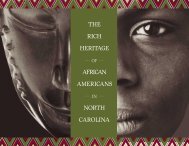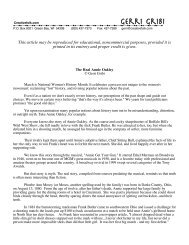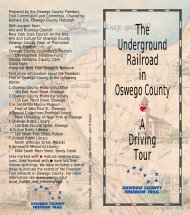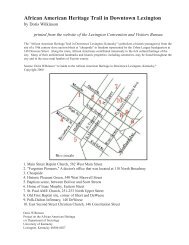Inside this brochure you'll find...
Inside this brochure you'll find...
Inside this brochure you'll find...
You also want an ePaper? Increase the reach of your titles
YUMPU automatically turns print PDFs into web optimized ePapers that Google loves.
istorically significant African-American communities grew in and around Annapolis as enslaved people<br />
became free. Parole and Eastport workers served the nearby City, the Naval Academy, or the maritime<br />
industry; Highland Beach provided a haven for African-American intellectuals and artists from around the Nation.<br />
MORNING<br />
Explore cemeteries, drive through the Parole neighborhood, tour the former<br />
resort, Highland Beach, and relax at Quiet Waters Park.<br />
ANNAPOLIS NATIONAL (VETERANS), BREWER HILL,<br />
AND ST. MARY’S CEMETERIES<br />
These cemeteries are just west of Westgate Circle on West Street in Annapolis.<br />
Annapolis National, established in 1862, contains remains of African-American<br />
soldiers and sailors who served in the Civil War, the Spanish American War,<br />
the Korean conflict, World War I, and II. Many are former slaves and free<br />
blacks who fought in the U.S. Colored Troops during the Civil War. Brewer Hill<br />
sits on land purchased in 1864 by two local African-American churches. This<br />
site was once known as a potters field for City slaves, criminals, and smallpox<br />
victims. Here lies memorials to Henry Davis, last man lynched in Maryland,<br />
and John Snowden, sentenced to death for a murder he may not have<br />
committed. St. Mary’s Cemetery, established in the 19th century, is the burial<br />
site for many of <strong>this</strong> area’s Catholics, including a small community of African<br />
Americans.<br />
PAROLE COMMUNITY<br />
Named for “Camp Parole,” a prisoner-exchange camp during the Civil War that<br />
grew to include six hospital buildings, numerous barracks, and many other<br />
buildings. An African-American “boom town” around the Camp grew into a<br />
permanent settlement for returning African-American veterans and their<br />
families. The area later became known for tomato canning. Today, Parole<br />
retains its cultural identity. A planned new Parole Heritage Area Tour highlights<br />
several early structures in the community, including Mt. Olive AME Church<br />
(1866) on Hicks Street, and the Parole Community Health Center on Drew<br />
Street.<br />
ARIS T. ALLEN MEMORIAL<br />
This memorial, at the intersection of Aris T. Allen Boulevard and<br />
Chinquapin Round Road in Parole, honors the late Dr. Allen, a noted<br />
physician and member of the Maryland State Legislature for many years.<br />
He was the first African American to chair the State Republican party.<br />
HIGHLAND BEACH<br />
FREDERICK DOUGLASS MUSEUM & CULTURAL CENTER<br />
3200 Wayman Avenue, Highland Beach • 410-267-6960<br />
Founded in 1893 as an African-American summer beach community by<br />
Frederick Douglass’ son Charles, a veteran Civil War officer, Highland Beach is<br />
the first chartered African-American township in the state of Maryland. It is<br />
America’s oldest black resort community. It has hosted many famous visitors,<br />
including retired Buffalo Soldier officers. Booker T. Washington had a vacation<br />
home here. Frederick Douglass’ summer cottage, “Twin Oaks” houses the<br />
Museum & Cultural Center (open by appointment).<br />
-4-<br />
QUIET WATERS PARK<br />
600 Quiet Waters Park Road • 410-222-1777<br />
Off Hillsmere Drive at the Forest Drive/Bay Ridge Rd. intersection, <strong>this</strong> 336-acre<br />
county park along the South River offers trails, boat rentals, picnic facilities, a<br />
gallery and eatery, and more. Patented in 1652, the property had been farmed<br />
for 300 years; African Americans once worked <strong>this</strong> land. Closed on Tuesdays.<br />
AFTERNOON<br />
Take the rest of the day to explore the maritime village of Eastport:<br />
EASTPORT<br />
This old neighborhood across Spa Creek from historic Annapolis had been<br />
farmland in colonial times. During the Revolution, French General Lafayette’s<br />
troops once encamped here. Incorporated as a subdivision in 1868, Eastport<br />
became home to African Americans and European immigrants who worked in<br />
and around the City as laborers, watermen, tradesmen, and boat builders.<br />
Today, Eastport’s maritime character lives on. A walking tour with markers<br />
highlights the history of the African-American community, as does the Annapolis<br />
Maritime Museum’s exhibits and café at McNasby Oyster Packing House, 723<br />
Second Street (410-268-1802). See the former three-room Eastport Colored<br />
School (corner of Third Street and Chester Avenue) now home of the Seafarers<br />
Yacht Club, an organization of African-American boaters. Dine at one of the<br />
many restaurants along the water.<br />
Frederick Douglass House (“Twin Oaks”)<br />
Camp Parole<br />
ead south of Annapolis for the day to explore a “lost” merchant town,<br />
former slave sites, archaeology digs, and nature trails. African-American<br />
history abounds!<br />
HISTORIC LONDON TOWN AND GARDENS<br />
839 Londontown Road, Edgewater • 410-222-1919<br />
Discover the remnants of a colonial merchant town c.1693 on the South River<br />
and walk among the scenic gardens. This “lost town” was a major port of call<br />
in the 1730s for ships taking tobacco to Britain and bringing African slaves,<br />
indentured workers, and convicts to Maryland. The town’s most dominant<br />
figure, James Dick, imported slaves on a large scale and used slaves in his<br />
ropewalk and other businesses. Slaves also manned the South River Ferry<br />
here. By the 19th century, London Town was abandoned except for the brick<br />
mansion (c.1760) used as a colonial tavern and home, and later as a county<br />
almshouse. Restored as a National Historic Landmark, the mansion and<br />
gardens are open for tours.<br />
ARCHAEOLOGY AND AFRICAN AMERICANS<br />
Recent digs at London Town have uncovered the foundations, cellars, and<br />
artifacts of <strong>this</strong> former colonial town. Also discovered was the site of a<br />
vanished 19th century African-American almshouse for men; artifacts are on<br />
display. Call to participate in ongoing archaeology digs.<br />
A SMALL CHILD<br />
“Traces of a burial suggest…that London Town slaves interred a child beneath<br />
the floor, in keeping with African traditions.” —Baltimore Sun 10-27-02<br />
The grave of a six-year-old child discovered under the floorboards of a longvanished<br />
building c.1730, is believed to be that of an African slave. It is the first<br />
such slave burial reported in the Chesapeake region. Such burials were<br />
practiced in Barbados and elsewhere in the Caribbean; many of London<br />
Town’s slave ships came from Barbados.<br />
A TWIST OF IRONY ON A SLAVE SHIP CALLED THE JENNY<br />
In 1760 the slave ship Jenny arrived at London Town with slaves from Angola.<br />
While on the high seas, the ship survived an attack by a French privateer<br />
because Jenny’s captain armed the slaves who then helped saved the ship.<br />
Ironically, upon reaching London Town, these same slaves were sold. Dozens<br />
of slave ships carried thousands of African slaves to Anne Arundel County<br />
during the 17th and 18th centuries.<br />
SMITHSONIAN ENVIRONMENTAL RESEARCH CENTER (SERC)<br />
647 Contees Wharf Road, off Muddy Creek Road • 443-482-2200<br />
SERC provides research and education programs for teachers, children, and<br />
the general public. Situated on property formerly part of Ivy Neck, Java, and<br />
Contee farms, it offers nature trails, picnic facilities, and programs focused on<br />
the Chesapeake Bay. It has tenant houses, one dating to slavery days, and an<br />
African-American burial site from the 1800s, listed with Maryland Historical<br />
Trust. SERC plans to interpret slave life in its Java Plantation exhibit.<br />
Open weekdays.<br />
-5-<br />
London Town Public House<br />
Slave Cabin, Contees Wharf Road<br />
Tenant House, Ivy Neck Farm<br />
“I do not know my mother or father…<br />
I was called ‘Gingerbread’ by the Revells.<br />
They reared me until I reached the age<br />
of nine or 10. Mr. Revell died in 1861 or<br />
62. The sheriff and men came from<br />
Annapolis…I was…sold …to a slave trader<br />
to be shipped to Georgia.”<br />
—JAMES WIGGINS<br />
fugitive slave











